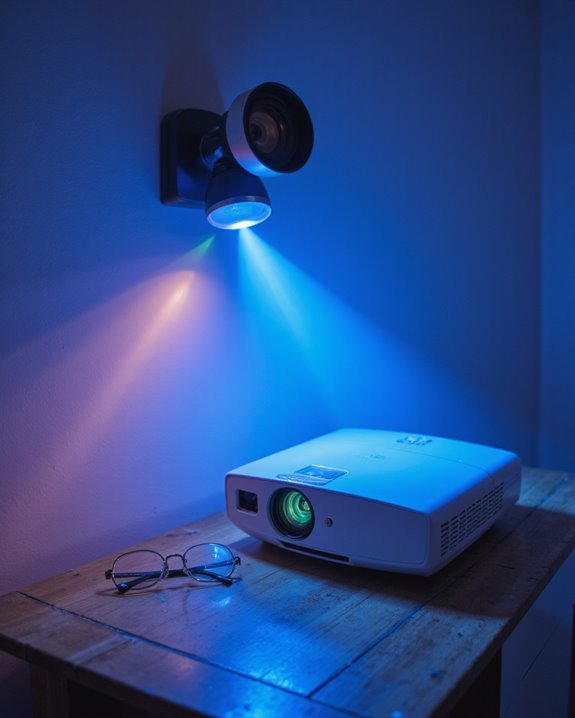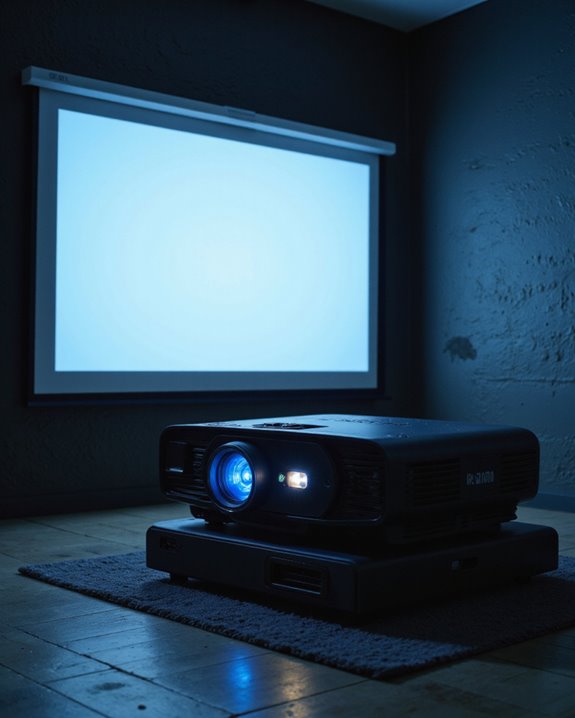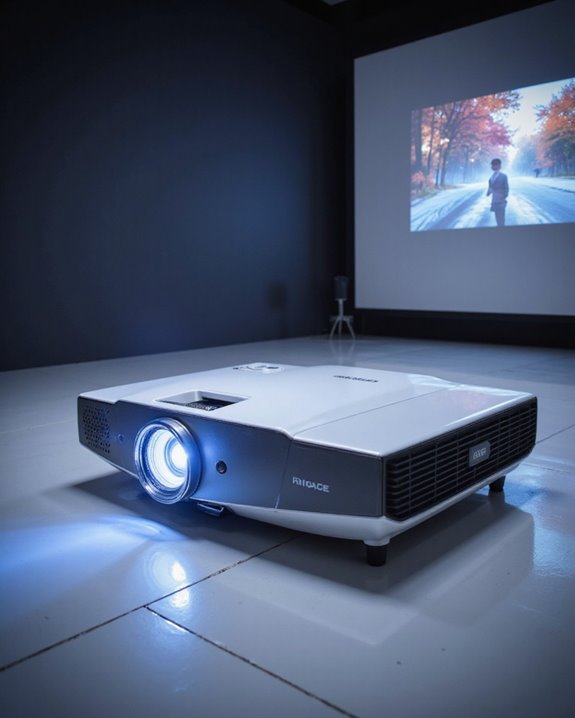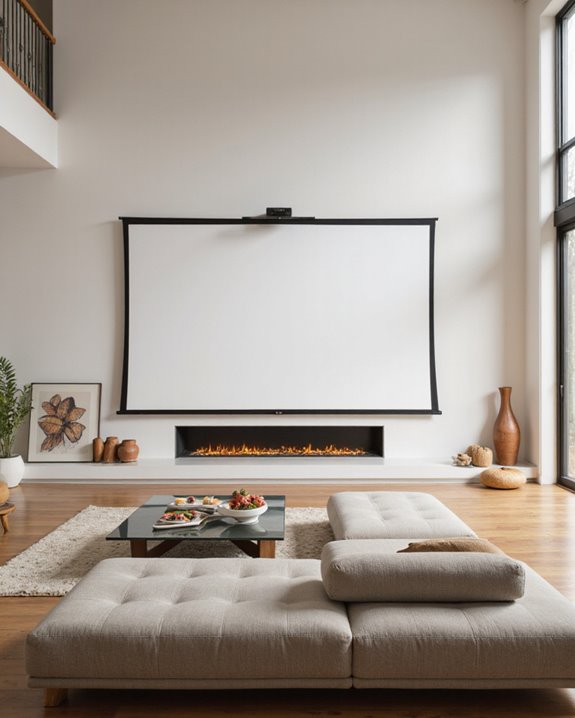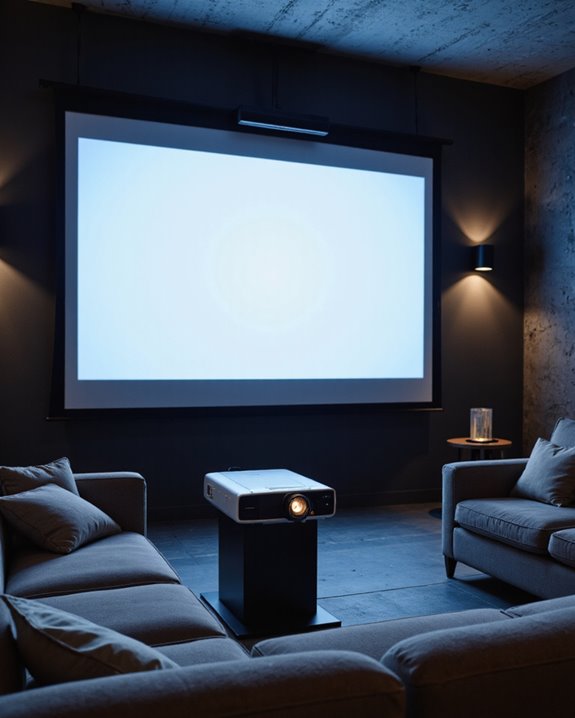Projectors do emit blue light—a high-energy visible (HEV) light between 400–450 nanometers—but typically at lower intensities and with more diffused, reflected light than smartphones, tablets, or TVs. This reduces direct exposure and may offer gentler viewing. Chronic blue light exposure can still lead to eye strain, potential retinal effects, and sleep disruption. Modern projectors use filters, warm color settings, and hybrid light sources to further limit blue light risks. Next, compare projector safety to other screens and discover reduction strategies.
Key Takeaways
- Projectors do emit blue light, but typically at lower intensity and concentration than TVs, smartphones, or computer screens.
- Projectors use reflected light, which is gentler on the eyes compared to the direct light emitted by TVs and monitors.
- Prolonged blue light exposure, even from projectors, can potentially contribute to eye strain and disrupt sleep patterns.
- Modern projectors often include blue light reduction technologies, such as special filters and adjustable color temperature settings.
- To minimize blue light exposure, adjust projector settings, control ambient lighting, and take regular breaks during use.
How Projectors Emit Blue Light Compared to Other Devices
Although many people worry about blue light exposure from electronic devices, projectors emit blue light differently compared to smartphones, tablets, and televisions. Projectors produce light that first bounces off a surface, such as a wall or screen, before reaching viewers. This reflected light is softer, and the emission intensity—how strong the light is—tends to be lower than the direct light from screens. The blue light spectrum, which refers to the range of blue wavelengths emitted, is also less concentrated in many projectors, especially in laser and LED models. Key differences include:
- Projectors emit less direct blue light than TVs or monitors.
- Reflected, diffuse light reduces overall emission intensity.
- Some projectors use special filters and technologies to lower blue light output.
This makes projectors generally less intense sources of blue light.
Eye Safety and Potential Hazards of Blue Light Exposure
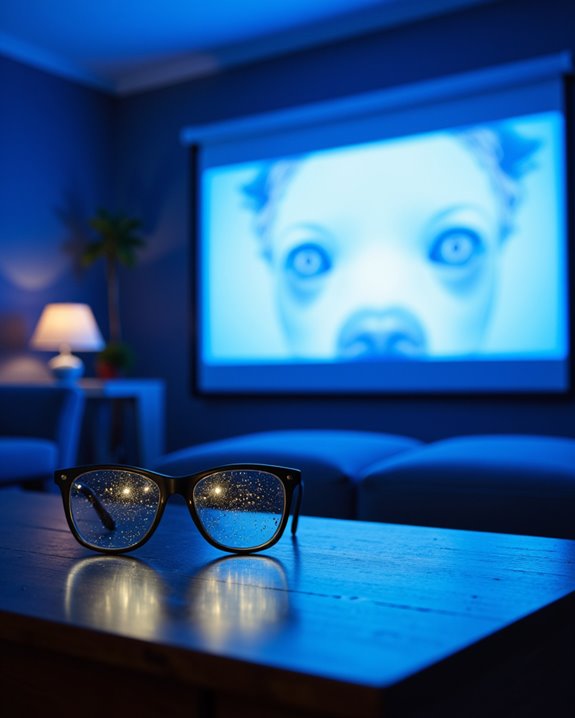
Because blue light is a high-energy visible (HEV) light with wavelengths between 400 and 450 nanometers, experts have raised concerns about its potential effects on eye safety and health. Prolonged exposure to blue light, emitted by devices such as projectors and screens, can pose several risks:
- Retinal health may be compromised, as high-energy blue light can cause phototoxic effects and potentially damage retinal cells.
- Chronic exposure has been linked to an increased risk of age-related macular degeneration (AMD).
- Blue light disrupts circadian rhythms, impacting sleep quality.
- Advances in projector technology aim to reduce blue light emissions and mitigate these risks.
Blue light filtration, using glasses or screen filters, can reduce exposure. Children are especially vulnerable due to less natural filtration in their eyes. Health agencies recommend limiting blue light, particularly in the evening, and scheduling regular eye exams for monitoring.
Projectors Versus TVS: Which Is Gentler on Your Eyes?

When comparing projectors and TVs for eye comfort, projectors generally offer several advantages. Projectors use reflected light, meaning the image bounces off a screen before reaching the viewer’s eyes. This reflected light is softer and less intense than the direct light emitted by TVs. Lower screen brightness in projectors helps reduce eye strain, while their larger screen sizes allow viewers to sit farther away, further increasing comfort. TVs, by contrast, emit direct light and often have higher brightness and contrast levels, which can cause more eye fatigue. Additionally, modern projectors incorporate blue light diffusion technology to further minimize eye discomfort during extended viewing sessions.
Practical Ways to Minimize Blue Light From Projectors
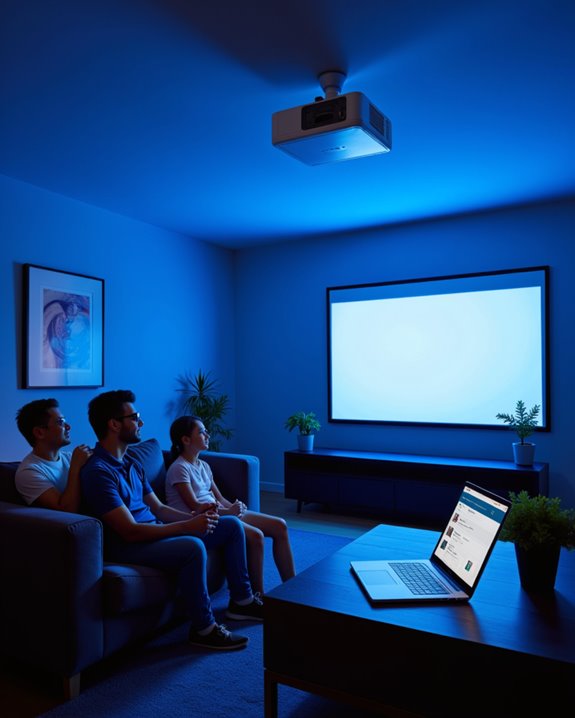
Projectors, while generally gentler on the eyes than TVs, still emit blue light that can contribute to eye strain and discomfort over time. To minimize exposure, several practical strategies are recommended. Screen adjustment is essential—lowering the color temperature to warmer tones and reducing brightness both help decrease blue light emission. Adjusting the contrast ratio can further balance light output. Ambient control, or managing the lighting in the room, is also important. This includes:
- Using dimmable, warm-toned lights,
- Avoiding direct glare on the screen,
- Leveraging natural light when possible.
Additional measures include applying blue light filters or screen protectors to the projected image, wearing blue light glasses, and following the 20-20-20 rule: take breaks every 20 minutes to rest eyes and reduce strain. Implementing projection technology that supports adjustable settings can also help tailor the image to healthier viewing standards.
Latest Research and Trends in Projector Blue Light Technology
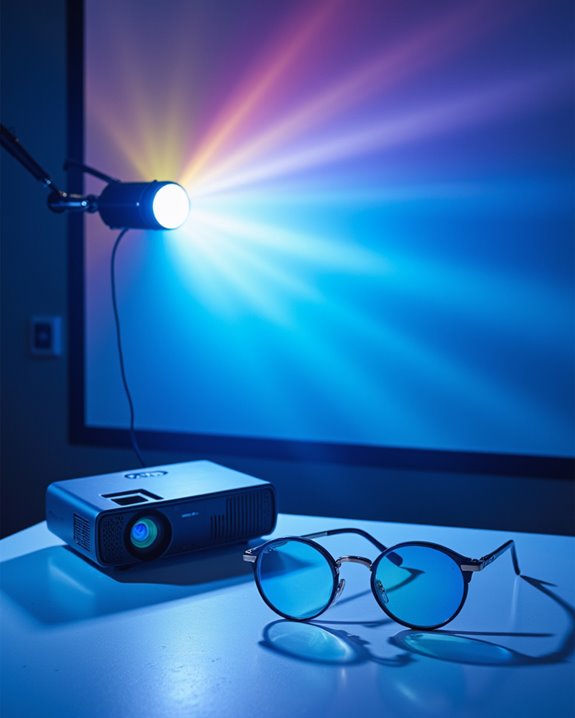
How have projector manufacturers responded to growing concerns about blue light exposure? The latest research shows a shift toward advanced light filtering methods and new display technologies. Manufacturers are now integrating quantum dot materials—tiny semiconductor particles that improve color and brightness—into projectors to enhance image quality and reduce blue light emission. Hybrid light sources, such as combinations of lasers and LEDs, use light filtering to specifically target and minimize harmful wavelengths in the 400-450 nanometer range.
- Micro LED projectors are under development, aiming to further decrease blue light output.
- Specialized filters, built into new projector models, reduce blue light without sacrificing sharpness.
- AI-powered smart projectors adjust brightness and contrast in real time to limit eye strain.
Patent filings highlight innovations in Micro-QLED and three-piece systems, focusing on efficient, safer projection.
Frequently Asked Questions
Can Wearing Blue Light Glasses Help While Watching Projector Content?
Wearing blue light glasses offers some blue light protection and may help reduce eye strain when watching projector content, especially during prolonged sessions or in dim environments, though benefits are less pronounced compared to direct-view screens like TVs or smartphones.
Are Certain Projector Brands Better for Eye Comfort?
Choosing a projector for eye comfort is clearly a life-or-death decision—brands like XGIMI, BenQ, and Epson tout superior projector brightness and screen resolution, while innovating blue light reduction features to pamper sensitive modern eyeballs.
Does Projector Screen Material Affect Blue Light Reflection?
Projector screen reflection and material impact are significant factors; high-quality and specialized materials can minimize blue light reflection and distribute light more evenly, potentially reducing eye strain and altering viewers’ overall perception of blue light during projection.
Is Blue Light From Projectors Harmful to Pets?
Blue light effects from projectors can pose risks to pet eye health, particularly with prolonged or intense exposure. Animal studies indicate potential retinal damage and circadian disruption, emphasizing the need to minimize pets’ exposure to projector blue light.
Can Projector Blue Light Cause Headaches or Migraines?
Much like a mischievous sprite weaving through a sunlit forest, blue light exposure can act as a migraine trigger for sensitive individuals, intensifying headaches and photophobia by activating specific neural pathways associated with light sensitivity and discomfort.

